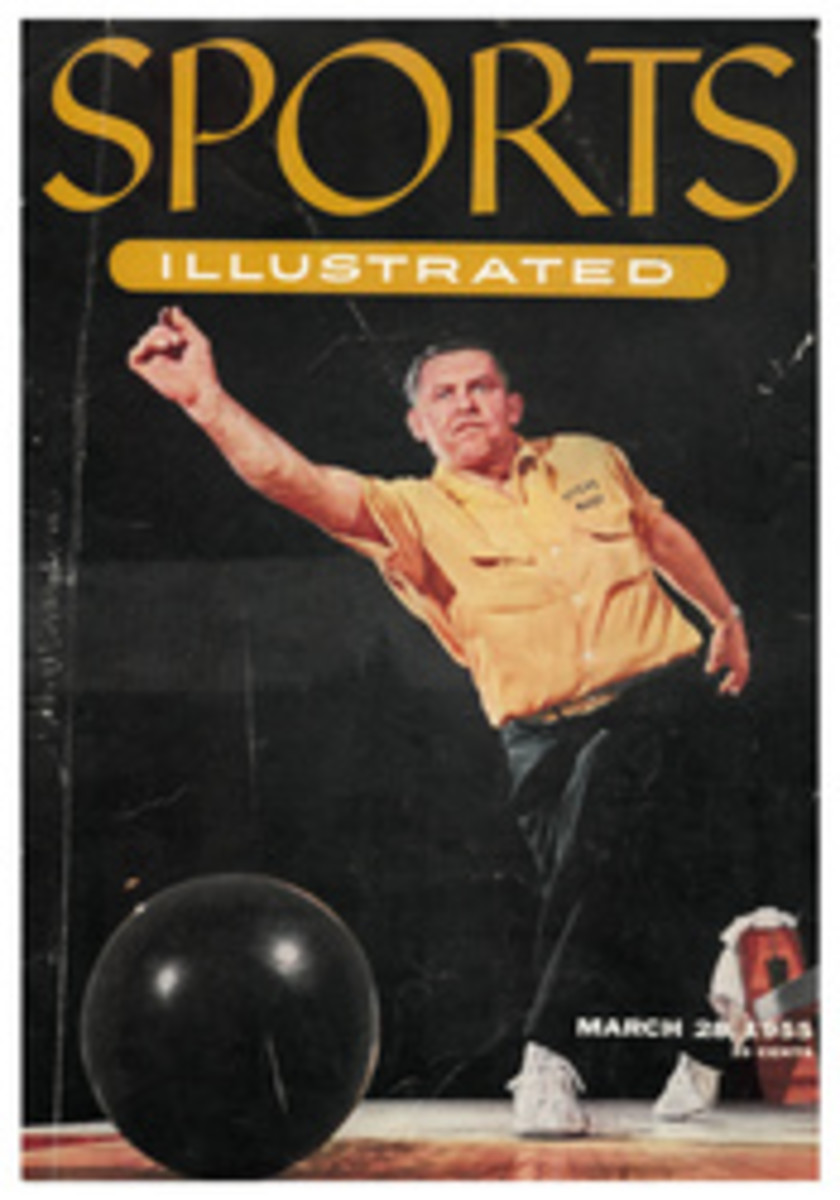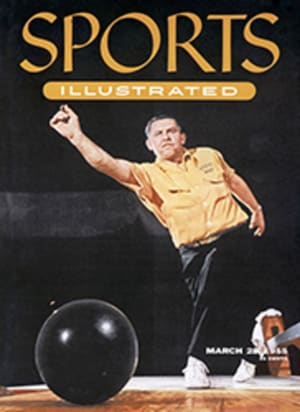
THIRTY THOUSAND BOWLERS
Handled carefully, as if they were bombs or babies, 38 pine-and-maple lanes and approaches were laid this week across a network of beams in the vast Memorial Coliseum at Fort Wayne, Ind. (above). By weekend they would be level and lacquered, ready for the first waves of some 30,000 bowlers who will compete for glory and a prize fund of $428,333 in the 52nd American Bowling Congress championships, the largest participation event and one of the most spectacular in the sports world.
From Elmhurst, Ill. will come Harry Steers, 74, "the iron man of bowling," for his 50th annual appearance. Steve Nagy, 41 (see cover), will come from Cleveland, hoping to become the first man in history to win the national match game championship and an ABC title in the same year.
Arriving from almost every state and from abroad will be bankers and farm hands, doctors, priests and oilfield workers, pinboys and Alaskan schoolteachers, students of 17 and retired millionaires in their 80s.
Colorfully uniformed contestants comprising 5,826 five-man teams, 11,312 doubles and 22,620 singles entries will roll for 72 consecutive days and nights (March 26 through June 5) before approximately 100,000 spectators, more than half of whom will accompany them from out of town. Bowlers and their rooters will spend an estimated $8 million for hotel rooms, food and entertainment and hundreds of thousands more for transportation.
More than 100 newspapers, magazines, news agencies and radio and television stations will send representatives to the tournament and at least 700 dailies and weeklies throughout the U.S., Canada and Hawaii plan special coverage of local bowlers.
The tournament, known simply as "the ABC" to the game's 20 million adherents, is composed of four main events: team, doubles, singles (each a three-game series) and all-events (total pinfall for the nine games). A fifth title will be awarded the under-851-average "booster" team recording the highest three-game score.
Considering the number of participants and the relatively high entry fee of $10 a man for each event, with $3 extra for a chance at the all-events fund, the top prizes are small: $2,500 in the team competition, $1,000 doubles, $500 singles and $1,000 all-events. This follows the tradition set by the founders of the congress, who organized the modern tenpin game in 1895 and inaugurated the national tournament six years later. To them good fellowship was more important than high scores and prestige more desirable than profit. The carefree, carnival-like atmosphere they created in the first ABC in a dimly lighted Chicago hall in 1901 pervades the ABC today.
In the current tournament, as in the 51 which preceded it, the vast majority of participants are duffers who will have trekked hundreds of miles and spent hundreds of dollars to be able to say they competed against a few hundred stars whose livelihood is bowling. There are only two or three teams in the entire East and perhaps two in the West which appear to have even a remote chance to win, yet Pennsylvania will be represented by 304 teams, New York by 238, New Jersey by 131, Iowa by 91, California by 46, and Texas will send 32.
ANYTHING CAN HAPPEN
The popularity of the ABC may be explained partially by the fact that in a three-game series anything can happen. In 1923 a young man named Carl Baumgartner, of Cincinnati, rolled 482 in the team event, then came through with 724 to win the singles. Eugene Gagliardi of Mt. Vernon, N.Y., Ray Brown of Terre Haute, Ind. and many others won the singles championship in their first ABC—and never came close again.
In 1946 Henry Kmidowski of Buffalo, a member of a booster team who apparently had no business in the doubles or singles, worked all night at a defense plant and then rolled 698 to give him and John Gworek, another low-average man, the doubles title. At least half of the singles and doubles crowns have gone to unknowns who, after bowling over their heads on one great night, returned to obscurity.
Above all, however, the ABC's drawing power may be attributed to the prestige it has acquired through the years. Other tournaments and sweepstakes offer far larger prizes and are sterner championship tests, but for stars and duffers alike the ABC is the high point of each season. For many old-timers it is the raison d'être of bowling; they enter a neighborhood league only to become eligible for the big annual event.
Since the event is held in a different section of the country each year, the turnover naturally is great. The first 51 tournaments drew 624,580 bowlers, most of whom rolled only when play was within 250 miles of their homes. But 189 have bowled in 25 or more ABCs, more than 1,000 have participated for at least 18 years and several thousand have passed the 10-year mark. By now, ABC is in their blood.
Iron Man Harry Steers, a wiry little man of 5 feet 5 inches and 142 pounds who bowled weekly in Chicago's Randolph League without missing a single game in 34 years, knocked down 82,672 pins in his previous 49 starts for a lifetime average of 188. He won the doubles in 1902 and both the doubles and all-events in 1918.
Steers's dream is to topple so many pins before he retires that no one will ever overtake him. Behind him, with 76,211 pins for 45 tournaments (also 188 average), is Tony Schwoegler, 70, of Madison, Wis., doubles champion in 1909 and father of two-time National Champion Conrad Schwoegler.
Steve Nagy, who in addition to being national champion holds the ABC doubles record of 1,453 with Johnny Klares of Cleveland (set in 1952, when Nagy also won the all-events), has gathered a team of stars which might well take the title this year. He will bowl in the doubles with Corp. Dick Hoover of Akron, who won the U.S. title in 1950 at the age of 21. Chuck O'Donnell, Nelson Burton and Gil Smith complete the quintet which will roll on April 11.
Among the other teams rated a fine chance are: on April 12, Hamm's Beer of Chicago, which won in 1954 in Seattle under a different sponsor and includes alltime greats Joe Wilman and Joe Norris (Wilman and the late John Koster are the only bowlers to have won four ABC titles); on April 13, Falstaff Beer of Chicago, led by former U.S. Champions Buddy Bomar and Ned Day; April 19, Pfeiffer Beer of Detroit, twice winner of the ABC and five times U.S. match champion, with George Young, current 10-year-average leader; April 24, Budweiser Beer of St. Louis, including two-time U.S. Champion Don Carter and defending ABC doubles titleholders Billy Welu and Don McClaren; May 12, Stroh Beer of Detroit, current U.S. match champion and generally considered one of the two or three best teams of all time.
AN ADDED ATTRACTION
As an added attraction for spectators, the fifth Masters Tournament—a double elimination event—will be staged on the Coliseum lanes for four nights beginning May 16. The country's 64 best bowlers will compete, rolling head-and-head matches based on total pins for four games. Contestants are eliminated upon losing two matches until, on the last night, only the two finalists remain.
This ABC is the fifth largest in history (the largest, 1953 in Chicago, drew 40,900 participants). Officials of the congress, who, incidentally, are elected by their city associations, are well satisfied with the number of entries. Their aim is to take the ABC into new territories and recruit new bowlers. Through this method they have built up their membership from 1,000 in 1901 to nearly 2 million today. They have done an excellent job because they, bowlers themselves, also have the ABC in their blood.
PHOTO
IN THE SHADOWY EMPTINESS OF A GREAT ARENA, WORKMEN LAY ALLEYS FOR FORTHCOMING ABC TOURNAMENT AT FORT WAYNE
PHOTO
MAN OF IRON, Harry Steers, still leads field in total pinfalls at 74 years of age.
PHOTO
FOUR-TIME WINNER, Joe Wilman, is sparking Hamm's Beer team of Chicago.

